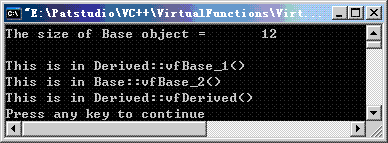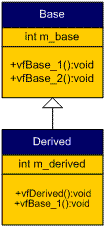转自http://blog.csdn.net/pathuang68/article/details/4101981
内容概要:
满足下面2个条件时,
1. 父类有虚函数,子类也有虚函数,且子类的虚函数重写或覆盖了父类的虚函数
2. 非虚继承
类对象之内存布局
前篇:http://blog.csdn.net/pathuang68/archive/2009/04/23/4101979.aspx
在前面的例子中,恢复原来的两个虚函数vfBase_1()和vfBase_2(),同时在Derived类中重写基类的虚函数vfBase_1(),Base类和Derived类之间的关系如下图:
整个代码如下:
#include <iostream>
using namespace std;
class Base
{
public:
int m_base;
inline virtual void vfBase_1()
{
cout << "This is in Base::vfBase_1()" << endl;
}
inline virtual void vfBase_2()
{
cout << "This is in Base::vfBase_2()" << endl;
}
};
class Derived : public Base
{
public:
int m_derived;
inline virtual void vfDerived()
{
cout << "This is in Derived::vfDerived()" << endl;
}
inline void vfBase_1()
{
cout << "This is in Derived::vfBase_1()" << endl;
}
};
typedef void (*VFun)(void);
template<typename T>
VFun virtualFunctionPointer(T* b, int i)
{
return (VFun)(*((int*)(*(int*)b) + i));
}
int main(void)
{
Derived d;
cout << "The size of Base object = \t" << sizeof(Derived) << endl;
cout << endl;
int i = 0;
while(virtualFunctionPointer(&d, i))
{
VFun pVF = virtualFunctionPointer(&d, i++);
pVF();
}
return 0;
}
运行结果如下:

Derived 对象的memory layout图解如下:

因为Derived类中重写了虚函数vfBase_1(),所以Derived::vfBase_1()就取代了Base::vfBase_1()的位置,位于虚函数表的开始处。而Base::vfBase_1()就不会再在Derived的虚函数表中出现了。



























 被折叠的 条评论
为什么被折叠?
被折叠的 条评论
为什么被折叠?








